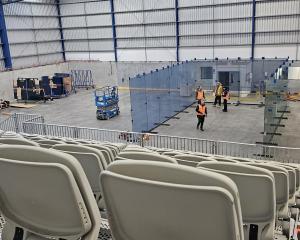
Earlier this month, the Timaru area was once again left without both frontline appliances.
The Timaru 801 fire engine has been in the workshop for several weeks awaiting parts from the United States. Its temporary replacement, a 31-year-old callout truck, then broke down and the Washdyke 817 returned to action last week after breaking down at the beginning of the month.
New Zealand Professional Firefighters Union (NZPFU) Timaru local secretary Paul Tilsley said union members were frustrated with the situation.
"A small town like Timaru gets the end of the line when it comes to fleet, which is understandable. Busy places get newer trucks but we’ve had a bit of a fleet crisis for a number of years now.
"New trucks haven’t been getting built and our two front trucks, whilst they’re within the desired age of 20 years, have both had faults at the same time which has meant they’ve both been off the run.
"We’ve had to again get older trucks than that to keep a fleet going locally. It’s not ideal."
The situation meant that for the past few weeks the Timaru fleet had been working with training centre trucks, Mr Tilsley said.
"Timaru has two main trucks, which are crewed 24 hours a day, seven days a week. One at Timaru, one at Washdyke, and then we have a call-out truck, which is our aerial combination pump truck that if any thing escalates, off-duty staff come in and man that truck.
"After that, we’ve just got one spare, which is supposed to look after the role of one of those first two trucks if they were to break down. So, when you have two breakdowns at the same time, that’s when the problem occurs.
"We’ve been forced to beg and borrow from the training centre, and bearing in mind, training centre trucks are even older, because they’re not fit to be on the road any more, and not fit to be a frontline response for clients.
"Whilst we’re very appreciative of the training centre being so generous in lending us a truck, it’s still not the sort of service we expect to be using and having to respond to the public with."
Filling the gap was a 35-year-old training truck on loan from the Woolston Training Centre.
Despite the union concerns about the ageing fleet, Fire and Emergency New Zealand organisational strategy and capability development deputy chief executive Sarah Sinclair said both on-duty crews from Washdyke and Timaru had adequate frontline fire trucks to meet their communities’ needs.
"All fire trucks spend some time out of frontline service to have proactive and reactive maintenance. This is usual for any fleet of heavy vehicles.
"As well as our dynamic fleet allocation, we have a backup [relief] fleet to cover when trucks are being maintained so our service to the community is not affected. In this case a relief truck has been used.
"As you would expect, our relief fleet is older than the frontline trucks normally on station and as newer appliances are brought in for busier stations around the country, older trucks will be replaced. We have an ongoing truck replacement programme with 70 new trucks currently on order."
Mr Tilsley said delayed response times and failure potential were the biggest dangers when using ageing equipment.
"A delayed response occurred just last week. What people don’t understand is the truck has got to get you to the job and then the truck engine runs the pump that supplies the water when you get to a fire.
"You get a lot of comparisons on Facebook posts about how people drive trucks that do a million kilometres in them. Well, that’s fine, that’s what those trucks are designed to do, they sit on the road at steady speed, revs, and they just travel.
"Fire trucks are expected to have four firemen jump into it, slam doors, and take off as fast as they can as quickly as possible. Hard acceleration, hard braking, cold starts, and in all manner of conditions.
"Then when the truck is actually at the job, if it’s a fire, it’s then required to pump water, which is, again, the motor being used differently to what a normal truck is."
He said with no new trucks being built and the use of a cascade system, it had been seven or eight years since a "new"’truck had been added to the Timaru fleet.
"I think you do need to put a new truck into a provincial brigade like the Timarus and the Nelsons of the world and things like that instead of just giving them the hand-me-downs that have been thrashed for 10 years already.
"All we can hope, I suppose, in the short term is that the new trucks that are arriving imminently come into the system and then we’ll eventually get something slightly newer as they cascade down. But we’re not holding our breath.
"I’d like to make the point that this is not directed towards the people that service and repair our trucks and fleet. They’re as frustrated as we are because they obviously see the age of them as well.
"They do the best they can with what they’re given and unfortunately, they’re given the same as us, old trucks that are becoming less reliable."












